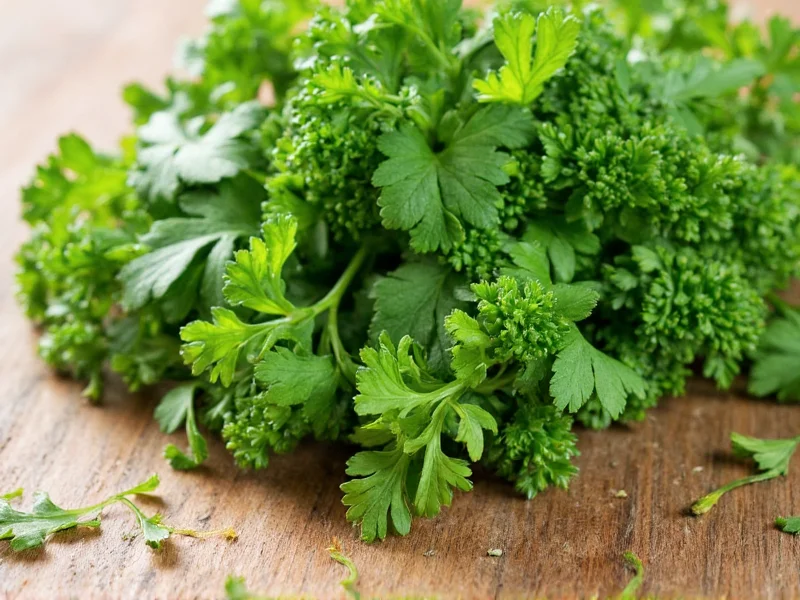Understanding how to properly convert between dried and fresh parsley is essential for achieving balanced flavors in your cooking. Many home chefs struggle with herb substitutions, often resulting in dishes that are either under-seasoned or overwhelmingly herbal. The key difference lies in moisture content—fresh parsley contains about 85% water, while dried parsley has most of its moisture removed, concentrating the essential oils and flavor compounds.
The Science Behind Herb Conversion Ratios
When herbs are dried, they lose approximately 75-85% of their original weight due to moisture evaporation. This concentration effect means that dried herbs deliver more intense flavor per unit volume. The standard culinary guideline of using one-third the amount of dried herbs compared to fresh isn't arbitrary—it's based on extensive testing by professional chefs and food scientists.
Precise Dried Parsley to Fresh Conversion Chart
| Dried Parsley | Fresh Parsley Equivalent | Best Usage Context |
|---|---|---|
| ¼ teaspoon | ¾ teaspoon, finely chopped | Delicate sauces, egg dishes |
| ½ teaspoon | 1½ teaspoons, finely chopped | Salad dressings, marinades |
| 1 teaspoon | 1 tablespoon, finely chopped | Most cooked dishes, soups, stews |
| 1 tablespoon | 3 tablespoons (¼ cup), finely chopped | Large batch cooking, hearty dishes |
Flavor Profile Differences You Should Know
While the 1:3 conversion ratio provides proper measurement equivalence, it's important to understand that dried and fresh parsley offer distinct flavor experiences. Fresh parsley delivers bright, grassy notes with subtle peppery undertones and a refreshing aroma. Dried parsley, by contrast, develops deeper, more earthy characteristics with slightly muted brightness. The drying process causes certain volatile compounds to evaporate while concentrating others.
For dishes where parsley plays a starring role—like tabbouleh or chimichurri—fresh is always preferable. In long-simmered dishes like soups, stews, and braises, dried parsley often performs better as it has time to rehydrate and distribute its flavor throughout the dish.
When Substitution Isn't Recommended
Certain culinary applications simply don't translate well between dried and fresh parsley. Garnishes and finishing touches should always use fresh parsley for its vibrant color and crisp texture. Similarly, dishes where parsley is the primary ingredient (like Italian gremolata or Middle Eastern za'atar variations) require fresh herbs for authentic results.
Conversely, dried parsley works poorly in applications requiring texture contrast or visual appeal. You'll notice professional chefs rarely use dried parsley as a finishing touch—the rehydrated texture lacks the crispness that makes fresh parsley such an effective garnish.
Storage Considerations for Optimal Flavor
Proper storage significantly impacts the potency of both dried and fresh parsley. Fresh parsley maintains best quality for 7-10 days when stored upright in a glass of water (like flowers) with a loose plastic bag covering, refrigerated. Dried parsley retains optimal flavor for 6-12 months when stored in an airtight container away from light, heat, and moisture.
Test your dried herbs for potency by rubbing a small amount between your fingers and smelling—strong aroma indicates good quality, while faint scent suggests it's time for replacement. Remember that older dried herbs may require slightly increased quantities to achieve proper flavor balance.
Professional Chef Tips for Perfect Herb Substitution
Seasoned chefs recommend adding dried herbs earlier in the cooking process to allow time for rehydration and flavor distribution. For most dishes, incorporate dried parsley during the first 15-20 minutes of cooking. Fresh parsley should be added in the final minutes or used as garnish to preserve its delicate flavor and vibrant color.
When substituting in recipes, consider the dish's cooking time and method. For quick-cooking dishes under 20 minutes, you may need to increase the dried herb quantity slightly (up to 50% more) since they have less time to rehydrate fully. For extended cooking times over 45 minutes, stick strictly to the 1:3 ratio to prevent overpowering the dish.
Common Conversion Mistakes to Avoid
Many home cooks make critical errors when converting between dried and fresh parsley. The most frequent mistake is using equal volumes (1:1 ratio) rather than the proper 1:3 measurement. This typically results in dishes that are either bland (using too little dried) or overwhelmingly herbal (using too much dried).
Another common error involves improper chopping technique for fresh parsley. To maximize flavor release and ensure even distribution, chop fresh parsley finely with a sharp knife rather than tearing it. The increased surface area allows for better flavor integration throughout your dish.











 浙公网安备
33010002000092号
浙公网安备
33010002000092号 浙B2-20120091-4
浙B2-20120091-4